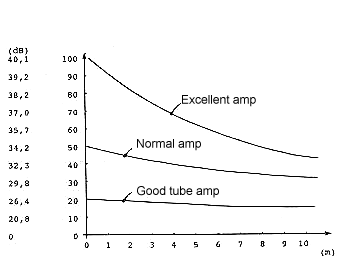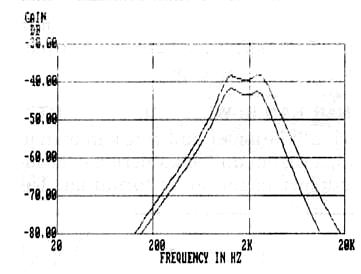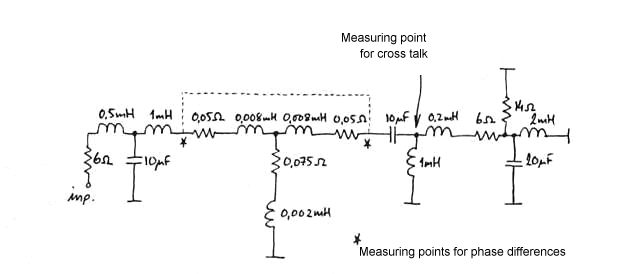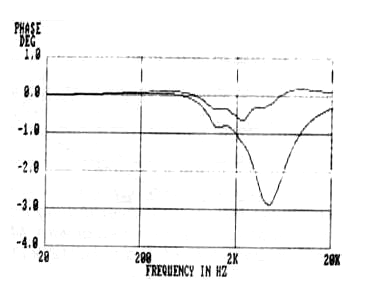
BI-WIRE, NOT ONLY AN ADVANTAGE
A popular method to connect an amplifier to a loudspeaker is to use something called bi-wiring. The technical idea behind this special way to connect has not reached the public in other words than "better definition in the mid range", "the bass will be faster" and "the treble more in focus" or similar nonsense. The problems and faults that arise have not been mentioned, of course.
THE ADVANTAGES FIRST
The idea with biwiring is to connect the amplifier to the filter halves separately to prevent intermodulation, generated by one driver, to influence the other driver.
If you look at the damping factor that reduces the unwanted signals however you will find that they differ very little with or without cables (with 5 or 0 metre long cables for example). When using a tube amplifier, the cables in practice have no influence at all to damp the signals from one side of the filter to the other, because the damping factor is too low already in the power amp. The signal will slip through anyway to the other driver, despite the cables.
Apart from that, a well-designed crossover filter will provide a certain protection against "leaking" intermodulation since each half of the filter (in a two-way system) will damp each half of the frequency range.

Picture 1: From this graph you can se what damping factor and real damping you get with different cable lengths and different cables (2.5mm2) and different amplifiers. With a good transistor amp the damping will be decreased about 4 dB with a 5-metre long cable. With a good tube amp, the damping will lose about 2 dB (the original damping with the tube amp was about 14 dB less however).

Picture 2: These two curves show the cross talk from the woofer to the tweeter. Bi-wire for the lower curve.

Picture 3: The diagram for the simulation. The two components at the far left simulate the woofer resistance and inductance. The two next is the lowpass filter for the woofer. Of the next six components, the horizontal represents the two cables and the vertical represents the output impedance of the amplifier. The broken line converts from bi-wire to single wire. Therefrom come two components representing the high pass filter to the tweeter and five components representing the tweeter.
Another point using double cables is the ability to choose separate cables that are especially suitable for each half of the frequency range. On the other hand, there are cables made along these lines without being double. (Monster, Isoda, MIT, and others) even if they do not work as the manufacturers claim, they have this in common, that for each frequency range, or level, they have different strand (different materials, areas, winding techniques and such) that are parallel connected. If you assume that the signal always takes the easiest path, the right strand will be chosen automatically.
AN ALTERNATIVE METHOD
You do not have to use separate cables to each driver, but may connect two or more cables in parallel if you think they have good qualities in different parts of the frequency spectrum and therefore may supplement each other. By that, it is not certain that you always can make such summing. If you think that it is possible to add a capacitor (that conducts at high frequencies) and a coil (that conducts at low frequencies) and get a circuit that conducts at all frequencies, you will be surprised when nothing gets through (!) at a frequency where each conducted decently before the connection. Cables, however, are less reactive and may therefore be summed without greater trouble.
THE DISADVANTAGE WITH BI-WIRE
One thing that happens when you biwire your loudspeakers is that the input of the high- and the low-pass filters are fed with different input signals. The difference is a result of the high frequencies and the low frequencies being forced to travel different paths, perhaps through different types of cables, but under all circumstances through cables who have seen different loads (a tweeter with a high pass filter has a completely different impedance response compared to a woofer with a low pass filter!).
What happens is that the drivers will work less good together than when their filter halves were fed with equal signals. The result is a generation of more static and stochastic phase error sounds at different directions from the loudspeaker. The stochastic phase error sounds appear because there may be different types of unlinearities in the low- and high-frequency paths.
What does this sound like? Well, usually, just as you may expect from physics, it appears as a change in the reproduction of space and sound stage. Often, the first impression is that the "biwired" sound presents extended "dimensions", more "air", and is more "living". The impression after a week or month, however, is that all recordings sound very much alike, and the "airiness" appears on all records. It does not even sound like air anymore, instead more like a slime that pollutes every record you play. No wonder, since it is not a real, recorded quality but a "speaker characteristic" added to all reproduced material. "Sameness" is another word for it.

Picture 4: This simulation is based on the diagram of picture 3. Here you can see that a phase difference has arisen when biwiring is used. The reason why the phase difference is largest just above the cross over frequency is that the inductance of the cable resonates with the capacitance of the high pass filter when not the inductance of the low pass filter is available in this range as when single wire is used. The most probable reason to the capricious sound of biwiring is that on top of this steady state error another, transient induced phase error between the cables will appear when playing music. This changes the radiation pattern of the speaker with the music. The human ear is very sensitive to such phenomena.
A condesation of two articles first published in "Musik och Ljudteknik", Autumn, 1990 and No. 1, 1998, Sweden. Text by Ingvar Öhman. Translated by Per Arne Almeflo, with permission from the author.